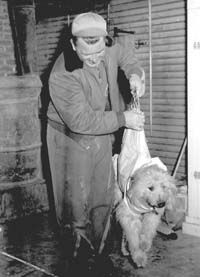| Buck Davis prepares a dog to for a parachute jump. The dog was later dropped to a sheepherder in the area who lost their dog. Davis was part of a number of supply drops and rescues during his tenure as airport manager of Carbon County Airport. |
Carbon County commissioners voted last week to rename the county airport. The airport will now be designated the Carbon County Airport – Buck Davis Field.
In August, Buck Davis’ son and daughter, Ron Davis of Denver, Colo., and Merilee Jeanselme of Price presented a proposal to the commissioners, asking that they consider renaming the airfield in honor of their father.
After the proposal was presented on August 3, the commission discussed the proposal at more than one meeting. Commissioner Steve Burge suggested that the county honor fellow commissioner Bill Krompel by naming the airfield the Davis-Krompel Field. He noted that various other facilities have been named after more than one person, citing the Bunnell-Dmitrich Athletic Center at the College of Eastern Utah.
Burge noted that over the course of his 17 years of public service, Krompel has made significant contributions to the airport.
When the commission asked Jeanselme at a later meeting whether that would be acceptable to her family, she replied that they preferred that their father’s name stand alone.
Commissioner Mike Milovich noted that there is more than one way to honor individual contributions and that the commission could recognize Krompel’s efforts using another method.
Buck Davis was born in North Platte, Neb., and moved to Price in 1945, just before the end of World War II with his wife, Frances, and three children. The family purchased the fixed base operation in Price and named the business the Carbon-Emery Flying Service.
In addition, Buck became the manager for the Carbon County Airport.
During the course of the next 28 years, Buck and his family lived at the airport and saw it turn from a gravel airstrip lacking modern conveniences to a more updated airfield that rivaled other airports in the state.
In 1945, the airport was accessed by a one-lane dirt road that crossed the landfill and draws that were often flooded after storms. The airport had a short dirt runway and a mid-length gravel runway. There were no runway lights, radio communications, weather observations nor navigation aids.
By the time Buck and his family left in 1973, the airport had three paved and lighted runways, including one long enough for jets aircraft to land and take off. Radio communications, weather observations and reporting, two instrument approaches and two navigation aids were also added over those 28 years.
In time, a two-lane paved highway was constructed from the airport to Price.
Buck taught more than 1,000 people to fly. In 1945, when he started teaching, he had one plane, a 1941 65 horsepower Taylorcraft. Frances acted as bookkeeper and office manager, and fueled planes when Buck was away.
As time progressed, the flight school had as many as seven aircraft and five instructors and charter pilots. In addition to flying charter flights, teaching, refueling and maintenance, Buck used his resources at the airport to perform various services in the community.
In the summer, he seeded clouds to create rain for agriculture. He sprayed crops for farmers in both Carbon and Emery counties.
Buck searched for missing aircraft, hikers, hunters, campers, boaters, cattle, horses and sheep. He flew injured ranch personnel out or remote mountain pastures and flew cowboys to and from Price when they competed in the Black Diamond Stampede.
He helped the state perform animal inventories by helping count game. The U.S. Forest Service used his services to assess fire risks. He also helped Carbon and Emery counties and the state monitor environmental pollution.
During the winter, he dropped feed to cattle and horses. When sheepherders lost their dogs, he dropped replacement dogs by parachute. When people were stranded in a remote area, he dropped food and other supplies for them until they could be rescued.
One winter, a caretaker of a water pump station in Range Creek became stranded in deep snow. Buck dropped supplies and Christmas presents to him until he was rescued in the Spring.
During the Uranium mining boom in Grand County, he flew prospectors to and from makeshift dirt strips. He provided prospecting services with Geiger counters installed on his airplane. Once gas and oil wells began in the area, he flew well crews to and from drilling sites.
He flew patients to and from Salt Lake City, Grand Junction and other cities. He flew prisoners to and from Price for law enforcement agencies.
When CEU and Carbon High developed aviation courses, he helped develop the program and taught ground courses.
“Because of his love of aviation, he always made time for youth groups who wanted to tour the airport,” said Ron Davis as he presented the proposal to commissioners.
After Buck left Price in 1973, he became a glider instructor in Heber City and gave flying instructions in Provo. In 1977, Buck moved to Sidney, Neb., where Buck gave flight instruction, piloted charter flights, and served on the Sidney Airport Board until 1996.
Buck’s last flight was in 1994 at the Carbon County Airport. Three generations of Davises celebrated the event with him.

